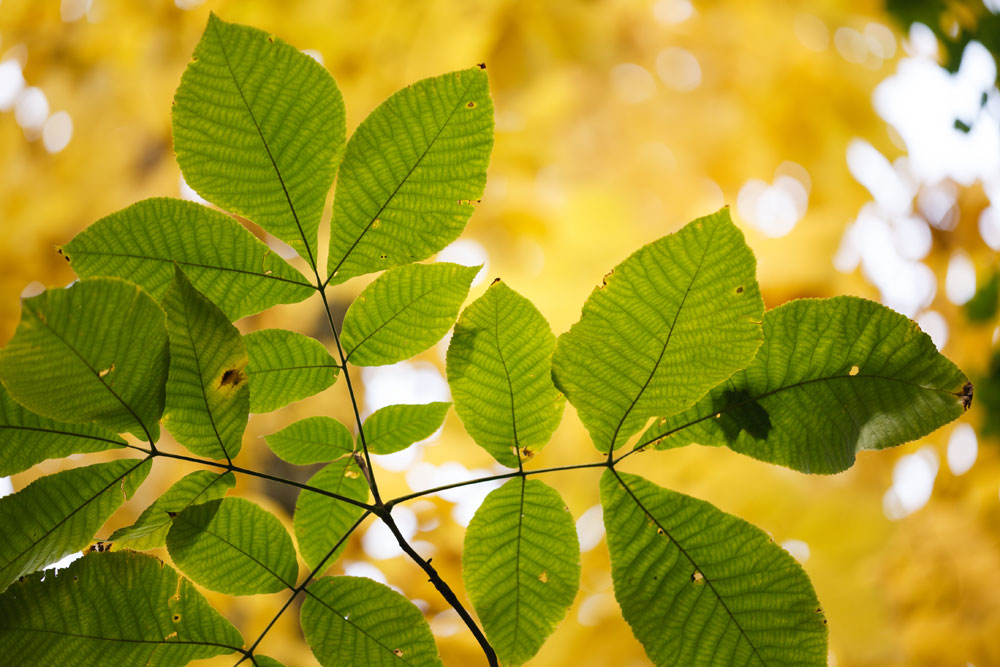
Hickory trees stand tall and proud, their majestic canopies casting dappled shade across forest floors and parklands alike. Yet, it’s their leaves that often capture the attention of curious onlookers and nature enthusiasts. In this comprehensive guide, we embark on a journey to unravel the enigmatic elegance of hickory tree leaves.
Quick Tips for Identifying Hickory Tree Leaves
- Observe Leaf Arrangement: Hickory tree leaves typically alternate along the stem, rather than growing directly opposite each other.
- Inspect Leaflets: Hickory leaves are compound, consisting of multiple leaflets arranged along a central stem. Count the leaflets to aid in species identification.
- Look for Nut Characteristics: Pay attention to the type of nuts produced by the tree, as different hickory species yield distinctively shaped nuts, which can help confirm leaf identification.
- Note Leaf Texture: Hickory leaves often have a slightly rough or leathery texture, with prominent veins running through them.
- Consider Leaf Color and Shape: While hickory leaves generally share common features, variations exist in leaf coloration and shape among different species, offering valuable clues for identification.
The Anatomy of Hickory Tree Leaves
Hickory tree leaves exhibit a fascinating array of shapes, sizes, and textures, reflecting the diversity within the genus Carya. Typically, hickory leaves are compound, consisting of multiple leaflets arranged along a central stem, known as the rachis. The number of leaflets can vary depending on the species, ranging from five to seventeen or more.
One distinguishing feature of hickory leaves is their alternate arrangement along the stem, meaning that leaves emerge one after the other, rather than in pairs directly opposite each other. This alternate pattern aids in the identification of hickory trees in the wild.
Venation patterns also play a crucial role in leaf identification. Hickory leaves typically exhibit pinnate venation, where veins extend outward from the central midrib like the branches of a feather. These veins provide structural support to the leaf and facilitate the transport of water and nutrients.
Texture and surface features further contribute to the unique character of hickory leaves. Depending on the species, hickory leaves may feel slightly rough or leathery to the touch, with prominent veins adding texture to the leaf surface. Leaf coloration varies from vibrant green in spring and summer to golden yellow or bronze in autumn, adding seasonal interest to the tree’s foliage.
Hickory Leaf Diversity
Within the genus Carya, several common hickory species showcase distinct leaf characteristics. Among them, the Shagbark Hickory (Carya ovata) stands out for its large, compound leaves with five to nine leaflets. As its name suggests, the Shagbark Hickory is known for its distinctive shaggy bark, adding to its allure in the landscape.
Pignut Hickory (Carya glabra) features compound leaves with five to seven leaflets, each with serrated edges, lending the tree a refined appearance. Bitternut Hickory (Carya cordiformis) boasts compound leaves with seven to nine leaflets, often with a yellowish-green hue in spring and summer, before turning golden yellow in the fall.
Mockernut Hickory (Carya tomentosa) showcases compound leaves with seven to nine leaflets, characterized by their slightly fuzzy undersides. These variations in leaf structure and appearance provide valuable clues for identifying hickory species in their natural habitats.
Ecological and Cultural Significance
Beyond their aesthetic appeal, hickory trees play a vital role in supporting biodiversity and ecosystem health. As native species in North America, hickories provide food and habitat for a diverse array of wildlife, including birds, mammals, and insects. The nuts produced by hickory trees serve as a valuable food source for wildlife, contributing to the ecological balance of forest ecosystems.
Furthermore, hickory nuts have been an important food source for indigenous peoples and early settlers in North America for centuries. Rich in protein and nutrients, hickory nuts were traditionally harvested, roasted, and ground into flour for use in various culinary applications. Today, hickory nuts continue to be prized for their unique flavor and nutritional benefits, with modern recipes incorporating them into baked goods, desserts, and savory dishes.
Culturally, hickory trees hold significance in folklore and traditional beliefs, symbolizing strength, resilience, and endurance. Indigenous cultures across North America revered hickory trees for their medicinal properties, craftsmanship potential, and spiritual significance, incorporating them into rituals, ceremonies, and everyday life.
Seasonal Changes and Adaptations
Throughout the seasons, hickory tree leaves undergo a remarkable transformation, reflecting the dynamic nature of the natural world. In spring, hickory leaves emerge from buds, unfolding in vibrant shades of green as they bask in the warmth of the sun. During the summer months, hickory leaves reach their full size and density, providing ample shade and shelter for wildlife.
As autumn approaches, hickory leaves undergo a spectacular change, transitioning from green to a kaleidoscope of colors, including golden yellows, fiery oranges, and rich browns. This vibrant display, known as fall foliage, attracts visitors from far and wide, eager to witness nature’s breathtaking spectacle.
In response to changing environmental conditions, hickory tree leaves have evolved various adaptations to ensure their survival. Deep-rooted and drought-tolerant, hickory trees can withstand periods of prolonged dryness, thanks to their ability to access water deep within the soil. Additionally, hickory leaves may exhibit adaptations such as waxy coatings or hairy surfaces to minimize water loss and protect against herbivores.
Threats and Conservation
Despite their resilience, hickory trees face a range of threats, including habitat loss, invasive species, and climate change. Urbanization and land development pose significant challenges to hickory tree populations, fragmenting their habitats and reducing connectivity between forested areas.
Pests and diseases, such as the hickory bark beetle and the thousand cankers disease, can also impact hickory trees, weakening their defenses and making them more susceptible to further damage.
Collaborative initiatives involving government agencies, nonprofit organizations, and local communities aim to restore degraded habitats, plant native trees, and raise awareness about the importance of hickory trees in supporting biodiversity.
Practical Tips for Leaf Identification
For those keen on identifying hickory tree leaves in their local environment, several practical tips can aid in the process:
- Consult Field Guides: Carry a reputable field guide to trees and shrubs, featuring detailed descriptions and illustrations of hickory tree leaves, bark, nuts, and other distinguishing features.
- Join a Nature Walk or Workshop: Participate in guided nature walks, workshops, or educational programs led by experienced naturalists or botanists, who can provide expert guidance on tree identification techniques.
- Use Smartphone Apps: Take advantage of smartphone apps designed for plant identification, which utilize image recognition technology to match photos of leaves with database entries for hickory trees.
- Attend Tree Identification Courses: Enroll in tree identification courses or workshops offered by local botanical gardens, arboretums, or conservation organizations, where you can learn hands-on techniques for identifying hickory trees and other native species.
By honing your observation skills and familiarizing yourself with the key characteristics of hickory tree leaves, you can develop a deeper appreciation for these magnificent trees and their role in sustaining healthy ecosystems.
Table of Things to Purchase Related to Hickory Tree Leaves
|
Item |
Description |
Price |
|
Field Guide to Trees |
Comprehensive guide featuring hickory tree leaves |
$20 – $30 |
|
Botanical Poster |
Illustrated poster showcasing hickory tree leaves |
$15 – $25 |
|
Gardening Tools |
Tools for maintaining hickory trees in home gardens |
$10 – $50 |
|
Hiking Backpack |
Gear for outdoor enthusiasts exploring hickory habitats |
$50 – $100+ |
|
Conservation Membership |
Support for organizations dedicated to hickory tree conservation |
$25 – $100+ |
Conclusion
In conclusion, hickory tree leaves offer a window into the rich tapestry of life that thrives within our forests and woodlands. From their diverse shapes and textures to their ecological and cultural significance, hickory leaves embody the beauty and resilience of the natural world.
As stewards of the land, it is our responsibility to cherish and protect hickory trees and their habitats for future generations to enjoy. By learning about hickory tree leaves and the ecosystems they support, we can foster a deeper connection with nature and inspire others to join us in safeguarding these invaluable resources.
So, the next time you find yourself wandering through a forest or park, take a moment to admire the intricate beauty of hickory tree leaves and reflect on the profound role they play in shaping our world.
